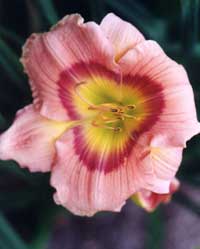 |
Modern Daylilies (Hemerocallis hybrids) are wonderful low-maintenance perennials, their popularity having encouraged the breeding of hundreds of named varieties now available. Unlike one of their parents, the familiar orange roadside standby, tawny daylily, modern hybrids bloom over many weeks. They are a staple of the perennial garden. When properly located modern daylilies need virtually no care and produce a succession of charming flowers daily. Hemerocallis, their scientific name, comes from the Greek, meaning "beautiful for a day." They grow practically anywhere. Because they are salt tolerant they are ideal for yards in coastal areas and along streets that get salted in the winter. Their succulent texture makes them useful for “firescaping” buffer zones in dry California neighborhoods.
Daylilies can be grown as far north as the Canadian border (Zone 3) and from New England to California, although certain ones do better in certain climates than others. Those classified as "dormants" die back over the winter and are most hardy over the country. "Evergreens" which stay green over the winter in the South do best there and in California. "Semi-evergreens" vary in the amount of cold they can tolerate. Some do well in the North in areas where there is dependable snowcover. Plants bought locally from reputable nurseries will likely be appropriate to your climate. Check catalogs carefully if ordering plants by mail.
Size: Modern daylily plants typically grow to 2 1/2 to 3 1/2 feet tall. Their branched flowering stems rising above the foliage another six inches or so. Their dense foliage clumps typically spread from 2 to 3 feet, though they can exceed 4 feet after a few years of multiplying. Miniature or dwarf types typically grow from 9 to 18 inches tall.
Foliage: Daylily leaves are mostly narrow, sword-shaped and pale to medium green. Rising in a clump from the crown of the plant at soil level, typically they're 1 to 2 feet long and up to 3/4-inch wide. They're evergreen in the South, but in Northern climates they die back to the soil, seeming to disappear until plants send up new green shoots in the spring.
Flowers: Typically, mature hybrid daylily plants send up dozens of stems, each with 5 to 9 fragrant flowers that open in succession over several days, each flower lasting a single day. Flowers are usually 3 to 4 inches long and may be single or double in form. While some are early, mid or late bloomers, many modern hybrids are "rebloomers" or "everbloomers," producing flowers all season. Flowers come in every color except blue, black and true white. They may be blended or patterned with color or even iridescent. Flower petals sometimes have ruffled or crimped edges and rippled texture. Those called tetraploids, because their chromosomes have been doubled by special chemical treatment, have larger flowers than ‘wild’ tawny daylilies. They are more vigorous and disease resistant too.
Some types of daylilies are called rebloomers because they form buds and bloom again in the fall. Others, called extended bloomers, continuously develop buds and bloom from early to late summer.

